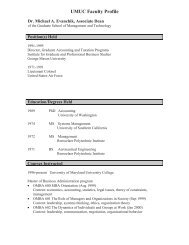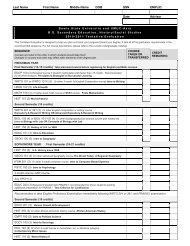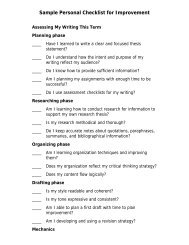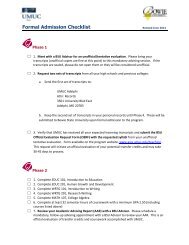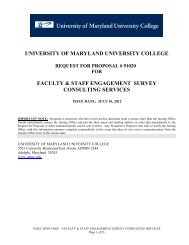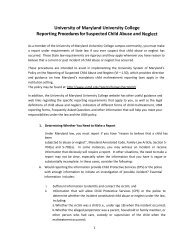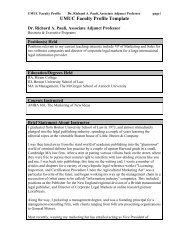1a. IntroSUS 2003 - University of Maryland University College
1a. IntroSUS 2003 - University of Maryland University College
1a. IntroSUS 2003 - University of Maryland University College
- No tags were found...
Create successful ePaper yourself
Turn your PDF publications into a flip-book with our unique Google optimized e-Paper software.
CMIS 330 S<strong>of</strong>tware Engineering Principlesand Techniques (3)Prerequisite: CMIS 240 or CMIS 315; CMIS 310 recommended.A study <strong>of</strong> the process <strong>of</strong> s<strong>of</strong>tware engineering from initial conceptthrough design, development testing, and maintenance toretirement <strong>of</strong> the product. Development life-cycle models are presented.Issues in configuration management, integration and testing,s<strong>of</strong>tware quality, quality assurance, security, fault tolerance,project economics, operations, human factors, and organizationalstructures are considered. Students may receive credit for only one<strong>of</strong> the following courses: CMIS 330 or CMIS 388A.CMIS 335 S<strong>of</strong>tware Safety (3)(Formerly CMIS 398S.) Prerequisite: CMIS 330. An examination<strong>of</strong> s<strong>of</strong>tware safety problems (including specification errors, design/coding flaws, or lack <strong>of</strong> generic safety-critical requirements) thatcan contribute to or cause a system failure. The objective is to providemanagement and engineering guidelines to achieve a reasonablelevel <strong>of</strong> assurance that s<strong>of</strong>tware will execute with an acceptable level<strong>of</strong> safety risk. Potential system hazards are analyzed as functional orgeneric and traced to either the s<strong>of</strong>tware or the environment inwhich the s<strong>of</strong>tware is used. Guidance on developing a process thatcan identify, analyze, and then prove, eliminate, or mitigate suchpotential system hazards according to priority is provided. Studentsmay receive credit for only one <strong>of</strong> the following courses: CMIS 335or CMIS 398S.CMIS 340 Programming in Java (3)Prerequisite: CMIS 240 or CMIS 315. An examination <strong>of</strong> the features<strong>of</strong> the Java programming language. Topics include design <strong>of</strong>classes, class libraries, data structures, exception handling, threads,input and output, and applet programming. Assignments includeprogramming in Java.CMIS 342 Windows User InterfaceProgramming (3)Prerequisite: CMIS 240. An introduction to Windows (Win32)user interface programming. The design and prototyping <strong>of</strong> userinterfaces in a Windows environment is examined. Focus is onprogramming controls, menus, and dialog and message boxes.Students may receive credit for only one <strong>of</strong> the following courses:CMIS 342 or CMIS 398W.CMIS 345 Object-Oriented Design andProgramming (3)Prerequisite: CMIS 240 or CMIS 315. An examination <strong>of</strong> theprinciples, practices, and applications <strong>of</strong> programming in anobject-oriented environment. Assignments include programmingprojects (in an object-oriented language such as C++ or Java) thatimplement techniques and language features <strong>of</strong> object-orienteddesign. Students may receive credit only once under this coursenumber.CMIS 370 Data Communications (3)Prerequisite: CMIS 310. Investigation <strong>of</strong> the effects <strong>of</strong> communicationtechnology on information systems. Major topics includecomponents <strong>of</strong> communication systems, architectures and protocols<strong>of</strong> networks, security measures, regulatory issues, and thedesign <strong>of</strong> network systems. Issues and applications in local areanetworks and communication services are covered. Students mayreceive credit for only one <strong>of</strong> the following courses: CMIS 370,CMSC 370, or IFSM 450.CMIS 375 Programming in Perl (3)(Formerly CMIS 398P.) Prerequisite: CMIS 140 or equivalentprogramming experience. An introduction to the Perl scriptinglanguage. The basic features <strong>of</strong> Perl (including data and variabletypes, operators, statements, regular expressions, functions, andinput/output) are covered. Additional topics include objectorientedprogramming and Common Gateway Interface (CGI)programming. Assignments include writing Perl scripts. Studentsmay receive credit for only one <strong>of</strong> the following courses: CMIS375 or CMIS 398P.CMIS 398F Database Forms (3)Prerequisite: CMIS 320. A comprehensive study <strong>of</strong> the designand development <strong>of</strong> graphical user interface forms for modernrelational databases in the client/server environment. Focus is ondeveloping a hierarchy <strong>of</strong> form applications using both Micros<strong>of</strong>tAccess and Oracle. Topics include the construction <strong>of</strong> simpleforms using drop-and-drag components and advanced features <strong>of</strong>vendor form-building products. Some Visual Basic and PL/SQLprogramming is used to provide robust functionality to the forms.Accurate display and processing <strong>of</strong> data and user friendliness arestressed.140





